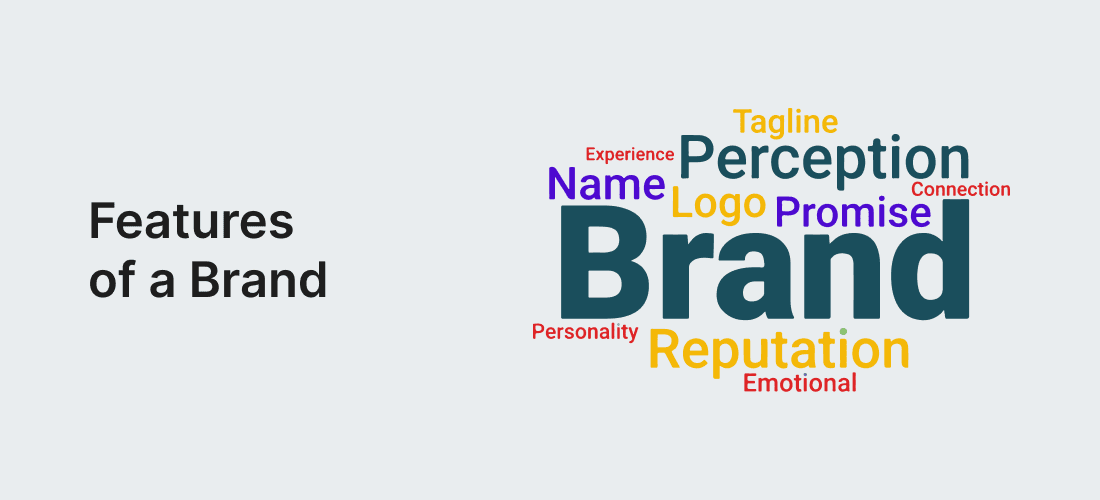
Aug 14, 2024

Sustainable growth in an increasingly competitive market requires businesses to create a lasting impression on their audience. This involves understanding and leveraging the concepts of brand, branding, and brand identity. While these terms are often used interchangeably, they each have distinct meanings and roles. In this comprehensive guide, we will explore the differences between brand, branding, and brand identity, and highlight the importance of branding and identity design services in creating a cohesive and memorable presence.
A brand is the perception of a company, product, or service as held by the public. It encompasses everything from the logo and visual elements to the customer experience and emotional connections.

A brand encompasses various elements that collectively define the perception, reputation, and emotional connection a company or product establishes with its audience. Here are the detailed features of a brand:
Perception refers to how the public views and feels about a company or product. It encompasses the collective thoughts, feelings, and opinions held by consumers, stakeholders, and the general public.
Reputation is built over time through consistent interactions and experiences that customers have with the brand. It is the long-term impression the brand leaves on its audience.
The brand promise is a commitment made to customers about what they can expect from the brand. It encapsulates the core values and benefits the brand aims to deliver.
The brand name is the unique identifier of the company or product. It is a critical component as it is often the first element recognized by consumers.
The logo is a visual symbol that represents the brand. It is a central element of brand identity, encapsulating the essence of the brand in a single graphic.
A tagline is a memorable phrase that encapsulates the brand’s essence and promise. It serves to reinforce the brand message and make it more memorable.
The brand personality consists of human characteristics associated with the brand. It shapes how the brand communicates and interacts with its audience.
Emotional connection is the bond that consumers feel with the brand. It is built through consistent, positive experiences and aligns with the consumers’ values and needs.
The brand experience encompasses all interactions a customer has with the brand, from the first point of contact to post-purchase support. It is the holistic perception created through these interactions.
Branding is the process of creating and managing a brand. It involves developing a strategy to shape how a brand is perceived and ensuring that all aspects of the brand align with this strategy.

Branding is the strategic process of creating, managing, and nurturing a brand to shape public perception, build loyalty, and differentiate it from competitors. Effective branding involves several key features that work together to establish a strong and cohesive brand presence.
Strategic planning in branding involves long-term planning to define the brand’s direction, goals, and strategies. It lays the foundation for all branding activities.
Brand messaging involves crafting clear, consistent, and compelling messages that communicate the brand’s values, promises, and personality to its audience.
The brand experience encompasses all interactions customers have with the brand across various touchpoints. It aims to create a positive and memorable experience that fosters loyalty and advocacy.
Visual and verbal identity involves creating and maintaining a cohesive and recognizable brand image through visual and verbal elements.
Consistency is crucial in branding to ensure that all brand elements and messages are uniform across all touchpoints. It helps build trust and recognition.
Differentiation involves creating a unique brand identity that sets the brand apart from competitors. It highlights what makes the brand special and why customers should choose it.
Building an emotional connection with customers is essential for creating a loyal customer base. It involves understanding and addressing the emotional needs and desires of the audience.
Adaptability in branding involves being flexible and responsive to changes in the market, customer preferences, and technological advancements.
Brand identity is the collection of all visual and tangible elements that represent a brand. It includes the design, colors, typography, and other elements that create a consistent look and feel.

Brand identity is the collection of all visual and tangible elements that represent a brand. It plays a critical role in establishing a cohesive and recognizable presence for a brand across various touchpoints. Here are the detailed features of brand identity:
The logo is the primary visual symbol of the brand, acting as a quick identifier for the company or product. It encapsulates the essence of the brand in a single graphic element.
The color palette consists of the specific colors used consistently in all brand materials. Colors evoke emotions and associations, playing a significant role in brand recognition and identity.
Typography involves the selection and use of fonts in all brand communications. The choice of fonts significantly impacts readability and the overall aesthetic of the brand.
Imagery includes the style of photos, illustrations, icons, and other visual elements associated with the brand. It helps convey the brand’s message and tone visually.
The brand voice and tone refer to the style and manner of communication used in all brand messaging. It reflects the brand’s personality and ensures consistency in how the brand speaks to its audience.
A tagline is a memorable phrase that encapsulates the brand’s essence and promise. It serves to reinforce the brand message and make it more memorable.
Brand guidelines, also known as a style guide, document the rules and standards for using the brand’s visual and verbal elements. They ensure consistency and coherence in all brand communications.
Visual consistency ensures that all visual elements of the brand are uniform across different platforms and materials. This helps in reinforcing brand recognition and trust.
For product-based brands, packaging design is a crucial element of brand identity. It involves designing the exterior of a product to reflect the brand and attract customers.
Signage includes any kind of visual display that communicates the brand in physical spaces, such as storefronts, trade shows, and office spaces.
| Aspect | Brand | Branding | Brand Identity |
|---|---|---|---|
| Definition | The perception and reputation of a company or product as held by the public. | The strategic process of creating and managing a brand to shape public perception. | The collection of visual and tangible elements that represent the brand. |
| Focus | Overall perception, emotional connection, and reputation. | Strategic planning, implementation, and management of brand activities. | Visual and tangible components such as logos, colors, and typography. |
| Scope | Intangible aspects like customer perceptions and emotional connections. | Comprehensive actions and strategies to build and maintain the brand. | Tangible visual elements used consistently across all platforms and materials. |
| Objective | Build trust, loyalty, and a positive reputation among customers. | Create a strong market presence, differentiate from competitors, and maintain consistency. | Ensure a cohesive and recognizable visual representation of the brand. |
| Components | - Perception - Reputation - Promise - Name - Logo - Tagline - Personality | - Brand strategy - Brand messaging - Brand experience - Marketing campaigns - PR | - Logo - Color palette - Typography - Imagery - Brand voice and tone - Tagline - Brand guidelines |
| Outcome | Customer loyalty and positive brand reputation. | A strong, differentiated, and consistent market presence. | Recognizable and cohesive visual elements that reinforce brand identity. |
| Example | How customers feel about and perceive Apple as a brand. | The actions Apple takes to promote and maintain its brand, such as marketing campaigns and PR. | The Apple logo, color scheme, typography, and overall visual style. |
| Emotional Connection | Built through customer experiences and interactions with the brand. | Developed through strategic communication and consistent brand activities. | Reinforced by visual elements that evoke specific emotions and associations. |
| Consistency | Achieved by maintaining a positive and reliable brand image. | Ensured through consistent implementation of brand strategies and messages. | Maintained by using the same visual elements across all materials and platforms. |
| Differentiation | Distinguishes the brand from competitors in the minds of consumers. | Strategies to highlight what makes the brand unique and valuable. | Visual uniqueness that sets the brand apart from competitors. |
| Long-Term Impact | Builds a lasting reputation and customer loyalty over time. | Sustained through ongoing brand management and strategic initiatives. | Creates a lasting visual impression that supports brand recognition and recall. |
Understanding the differences between brand, branding, and brand identity is crucial for creating a cohesive and effective presence.
This table provides a clear comparison of the concepts of brand, branding, and brand identity,
Also Read – What is Brand Design-Comprehensive Guide
Branding and brand identity design services are professional services that help businesses create, develop, and maintain their brand and its visual representation. These services are crucial for ensuring that a brand is effectively communicated and consistently represented across all platforms.

Investing in professional branding and brand identity design services offers numerous benefits that can significantly impact a business’s success.
Understanding the differences between brand, branding, and brand identity is crucial for creating a cohesive and effective presence in the marketplace. While a brand represents the overall perception and emotional connection, branding is the strategic process of building and managing that perception. Brand identity, on the other hand, consists of the visual and tangible elements that represent the brand.
Investing in professional branding and brand identity design services can significantly enhance brand recognition, improve customer loyalty, provide a competitive advantage, increase market reach, and streamline marketing efforts. By leveraging these services, businesses can create a strong and memorable brand that resonates with their audience and drives success in the competitive landscape of 2024.